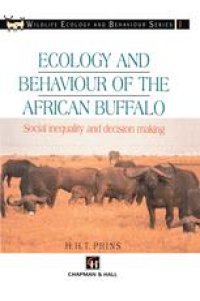
Ebook: Ecology and Behaviour of the African Buffalo: Social inequality and decision making
Author: H. H. T. Prins (auth.)
- Tags: Ecology, Nature Conservation, Evolutionary Biology, Zoology
- Series: Chapman & Hall Wildlife Ecology and Behaviour Series
- Year: 1996
- Publisher: Springer Netherlands
- Edition: 1
- Language: English
- pdf
Over the past 30 years or so, research effort in behaviour and ecology has progressed from simple documentation of the habits or habitats of differ ent species to asking more searching questions about the adaptiveness of the patterns of behaviour observed; moved from documenting simply what occurs, to trying to understand why. Increasingly, studies of behav iour or ecology explore the function of particular responses or patterns of behaviour in individuals or populations - looking for the adaptiveness that has led to the adoption of such patterns either at a proximate level (what environmental circumstances have favoured the adoption of some particular strategy or response from within the animal's repertoire at that specific time) or at an evolutionary level (speculating upon what pres sures have led to the inclusion of a particular pattern of behaviour within the repertoire in the first place). Many common principles have been established - common to a wide diversity of animal groups, yet showing some precise relationship between a given aspect of behaviour or population dynamics and some particular ecological factor. In particular, tremendous advances have been made in understanding the foraging behaviour of animals - and the 'decision rules' by which they seek and select from the various resources on offer - and patterns of social organization and behaviour: the adap tiveness of different social structures, group sizes or reproductive tactics.
What are the benefits that animals gain from living in a social group? This question has been the primary focus of the author's ecological interest. After many years of original and innovative research on the African buffalo, particularly at Lake Manyara in northern Tanzania, Herbert Prins has now summarized the results of much of this widely-respected work in this fascinating book. While advantages in reduction of the risks of predation or in increased efficiency of foraging on certain types of resources are now widely recognized, until now there has been less attention paid to the idea of the animals themselves as `information centres' and the extent to which the individual may be able to make use of information gathered by conspecifics, adjusting its own behaviour in response. Such a case-study has wide implications for research on social structure and organization in other species, and these are explored within the book. However, it is not a book aimed simply at the academic researcher, zoologist and behavioural ecologist; since it is written in a readable and accessible style, the book will also be enjoyed by wildlife enthusiasts, interested naturalists, wildlife biologists and wildlife managers.
What are the benefits that animals gain from living in a social group? This question has been the primary focus of the author's ecological interest. After many years of original and innovative research on the African buffalo, particularly at Lake Manyara in northern Tanzania, Herbert Prins has now summarized the results of much of this widely-respected work in this fascinating book. While advantages in reduction of the risks of predation or in increased efficiency of foraging on certain types of resources are now widely recognized, until now there has been less attention paid to the idea of the animals themselves as `information centres' and the extent to which the individual may be able to make use of information gathered by conspecifics, adjusting its own behaviour in response. Such a case-study has wide implications for research on social structure and organization in other species, and these are explored within the book. However, it is not a book aimed simply at the academic researcher, zoologist and behavioural ecologist; since it is written in a readable and accessible style, the book will also be enjoyed by wildlife enthusiasts, interested naturalists, wildlife biologists and wildlife managers.
Content:
Front Matter....Pages i-xxiii
Distribution of resources in time and space....Pages 1-33
Food for the buffalo....Pages 34-55
Social organization of buffalo cows....Pages 56-83
Social organization of buffalo bulls....Pages 84-105
Population dynamics, catastrophes and stability....Pages 106-153
Competition for food....Pages 154-177
Patch selection: predators and grazing by ‘rule of thumb’....Pages 178-217
Selecting grazing grounds: a case of voting....Pages 218-236
The effects of ecology on social organization....Pages 237-260
Back Matter....Pages 261-293
What are the benefits that animals gain from living in a social group? This question has been the primary focus of the author's ecological interest. After many years of original and innovative research on the African buffalo, particularly at Lake Manyara in northern Tanzania, Herbert Prins has now summarized the results of much of this widely-respected work in this fascinating book. While advantages in reduction of the risks of predation or in increased efficiency of foraging on certain types of resources are now widely recognized, until now there has been less attention paid to the idea of the animals themselves as `information centres' and the extent to which the individual may be able to make use of information gathered by conspecifics, adjusting its own behaviour in response. Such a case-study has wide implications for research on social structure and organization in other species, and these are explored within the book. However, it is not a book aimed simply at the academic researcher, zoologist and behavioural ecologist; since it is written in a readable and accessible style, the book will also be enjoyed by wildlife enthusiasts, interested naturalists, wildlife biologists and wildlife managers.
Content:
Front Matter....Pages i-xxiii
Distribution of resources in time and space....Pages 1-33
Food for the buffalo....Pages 34-55
Social organization of buffalo cows....Pages 56-83
Social organization of buffalo bulls....Pages 84-105
Population dynamics, catastrophes and stability....Pages 106-153
Competition for food....Pages 154-177
Patch selection: predators and grazing by ‘rule of thumb’....Pages 178-217
Selecting grazing grounds: a case of voting....Pages 218-236
The effects of ecology on social organization....Pages 237-260
Back Matter....Pages 261-293
....